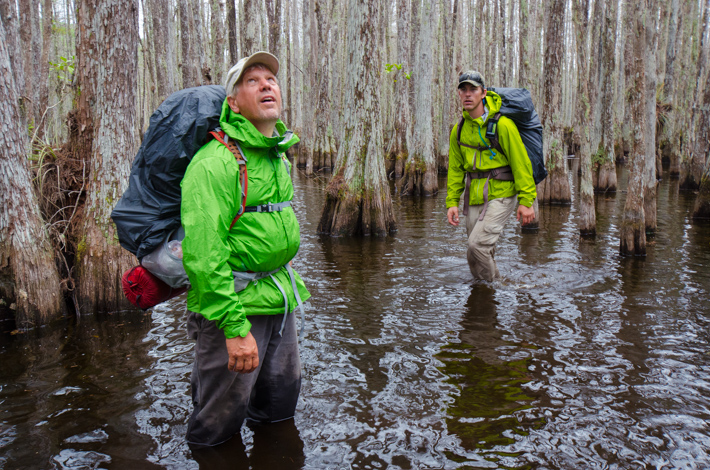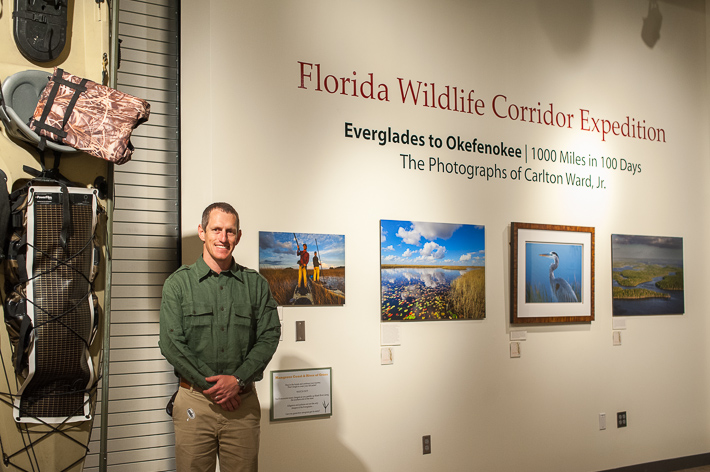Photographer Carlton Ward Jr. doesn't want to save the world with his imagery but he definitely wants to try and save Florida. Specifically, a wildlands passageway that connects the Everglades of southern Florida to the Okefenokee swamp in Southern Georgia. For 100 days in 2012, he, along with a filmmaker, bear biologist and conservationist, crossed the entire state in a continuous path using kayaks, paddleboards, bicycles, horses and their own feet. The visual chronicle was recently published as a book and broadcast as a PBS special.
I first met Carlton Ward after moving to Tampa in the fall of 2007 and I was very intrigued with his photographic career. He was working to complete a Masters degree in Ecology with a thesis on Conservation Photography at the University of Florida and had recently completed seven expeditions to Gabon creating a biological catalogue of its indigenous species in a partnership with the Smithsonian Institution. The resulting imagery was published in numerous European and American magazines, a large-scale book “The Edge of Africa”, and exhibited internationally.
Coming back from Africa, he realized with great clarity how important his photographic work could be if he undertook a similar project that focused on Florida and its often-overlooked interior landscapes, including vast cattle ranches and wildlife habitats. In 2009 the University of Florida press published his second monograph "Florida Cowboys," an evocative visual and written study of Florida's cattle ranching communities and the varied species that inhabit this landscape. Beyond the publication in book format, "Florida Cowboys" was widely exhibited across the state at venues that included the Tampa Bay History Center, Florida Museum of Natural History and Palm Beach Photographic Center.


Photos by Carlton Ward Jr. / CarltonWard.com
In Fall 2010, he and I had lunch and he mentioned an elaborate trek concept in which he envisioned traversing the state of Florida in an effort to raise awareness for protecting and connecting remaining wild spaces. He reminded me how National Geographic Explorer Michael Fay had walked across Africa in a journey called the "Megatransect," a conservation-awareness campaign that ultimately let to the establishment of 13 new national parks.
Carlton wanted people to understand the interconnectedness of the ecosystems but also to realize how unguided urban and rural sprawl could sever these wild communities. This could easily create orphaned wildness habitats that could isolate species and hasten the extinction of native species like the indigo snake, Florida black bear, Florida panther, scrub jay and snail kite.
“I want people to see that Florida has an amazing wildlife corridor running the length of the state that we still have an important opportunity to connect and protect,” said Carlton.
A year later, Carlton had recruited a team for the trek, now named the Florida Wildlife Corridor Expedition. It included Elam Stoltzfus, an award-winning documentary filmmaker, Joe Guthrie, a bear biologist whose work helped inspire the corridor vision and Mallory Lykes-Dimmit, a conservationist with the Nature Conservancy. With support and grant money from an array sponsors including National Geographic and the Everglades Foundation, gear partnerships from Lifeproof, Patagonia, Yolo paddleboards to name a few, and film sponsorship by Mosaic, the journey kicked off on January 17th last year with a week of sea kayaking in the Everglades.

Photo by Carlton Ward Jr. / CarltonWard.com
To document the trek, Carlton used Nikon D7000 cameras outfitted with GPS receivers and 128GB CF cards. The iPhone 4s in a Lifeproof waterproof housing was also used to post mobile imagery and quick video clips to social media platforms. A support vehicle containing backup camera bodies and lenses along with the team's expedition equipment would rendezvous with the team periodically during the journey. This provided an opportunity to download and backup imagery to a laptop and external drives but Carlton never reformatted the 128GB SD card as a precaution. His studio manager Lisa Baylor was a constant point of contact as she managed his business during the long adventure in the field. She would often meet the team during their rendezvous points to swap out external drives so the imagery could be incorporated into the archive back at the studio. The GPS coordinates were essential for file organization and keywording as the images provided a comprehensive visual chronicle of the 100-day journey.
During a wet day in the northern Everglades, Carlton dunked his D7000 in Josephine Creek. He immediately removed the battery and poured the water out of the body. Then while visiting a ranch the next day, he baked the camera and lens in a convection oven for 16 hours on lowest setting with the door cracked. Somehow the camera came back to life and he was able to continue shooting with it for the next 60 days of the expedition (and still uses it today). Later in the journey, he drowned the lens a second time and had to send it to Nikon for repair.
The team successfully completed their journey on April 25, 2012 and was joined by Michael Fay for the last week and conclusion of the trip in the Okefenokee National Wildlife Refuge. In many ways, the final day in the field was only the beginning for Carlton's photographic work. The rapid pace of crossing so much land on such a tight schedule had restricted his ability to really do visual justice to the entire landscape.
“The biggest photographic challenge was having to work on the fly,” said Carlton. “Because of other priorities – we had to trek an average of 13 miles every day, host reporters and VIP guests, sustain daily media posts from the field, and conduct interviews for the film – I seldom had the opportunity to slow down and wait for the light. I could call it a 100-day scouting trip – I started a long list of places I intended to revisit with more time.”
He knew that the project would likely have several opportunities for public exhibition and he felt that a book was an essential way of furthering the Florida Wildlife Corridor message. Throughout the fall months of 2012, he returned to specific spots along the corridor to reshoot them in better weather, taking advantage of time to wait for light that he didn't have during the trek. By January, he was in the final stages of book layout for the FWC book and hastening to get it to the printer in time for the opening reception for an exhibition of the imagery at the Palm Beach Photographic Centre in West Palm Beach, Florida.



Photos by Carlton Ward Jr. / CarltonWard.com

Photo of Carlton Ward Jr. by Joseph Gamble / JCGamble.com
“I am doing everything I can to bring attention to stories within the broader Florida Wildlife Corridor story,” he said. “For example, I'm working to expand my network of camera traps through corridor and I'm beginning a new project on Florida Forests.”
“ I encourage everyone to get out and explore Florida on their own, from kayak excursions to hiking the Florida National Scenic Trail,” said Ward.
For more information on the Florida Wildlife Corridor Expedition, check out their web site and for more of the wildlife imagery of Carlton Ward Jr., visit his web site or his National Geographic Explorers bio. His latest book “Florida Wildlife Corridor Expedition” can be purchased online and you can follow the latest updates on the corridor via Twitter and Facebook.
All images are published here with the permission of Carlton Ward Jr. and the Florida Wildlife Corridor.






Did they say that he was using a D7000 with 128GB CF cards?
Yes Alejandro. That was his primary camera.
I caught that too - I'm sure they meant SD cards.
Good catch. SD not CF.
When I switched from CF to SD I had a hard time not referring to them as CF's - I mentally equated CF's with "real cameras" and SD's as point-n-shoot's! For a situation like this where you are in a high-risk (boats, water, sand, etc) situation and a camera with multiple slots, I think I would do RAW+JPEG with the second (JPEG) card being an EyeFi that was beaming to something in a waterproof bag!
that's funny. I am sure it was a slip, no biggie, I was just wondering myself.
Great work!
Great photography story.
Don't these people have jobs?
This IS their job: using their education and artful use of technology, they hand us an awareness of the treasure that is Florida's astounding beauty and the natural FL which potentially holds sustainability for all of us, the critters in our natural habitats and people included. In all regards, Florida will only remain stable or improve if we fully engage in taking care of it (because there are many whose only interest is to exploit it and us). And though we are not all able to explore all of Florida's gifts and wonders, the awareness of their existence is key, both as the first step and as our motivation to work together protecting, preserving, and enhancing our natural Florida.
OH, and that "trick" of putting a camera in the oven? I did that to my Minolta SRT101 in 1977
I first became aware of the Florida Wildlife Corridor Expedition one rainy day watching PBS. I was inspired toward conservation and land stewardship. About a week later, I happened upon Carlton Ward's exhibit at our Palm Beach Photographic Center in downtown West Palm Beach..
The photographs from this expedition are magnificent. I found the story of the tagged black bear to be especially interesting.
I hope to be able to follow Carlton's work in the future.